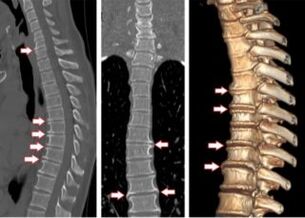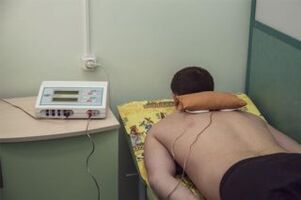Osteochondrosis is the main cause of back pain. The thoracic spine is less frequently affected than other parts, initially it is less mobile. Due to the lack of characteristic symptoms, degenerative disease is more difficult to diagnose. Inappropriate treatment has serious consequences.
Degrees and symptoms of osteochondrosis.

Dystrophic lesions of bone and cartilage tissue are the most common chronic human diseases. The pathological process begins with the nucleus of the intervertebral disc, then spreads to the annulus fibrosus. Atrophied cartilage loses its cushioning properties and increases the load on the bone. The gap between the vertebrae is reduced, bumps and hernias appear, nerve endings are pinched.
Pathology symptoms:
- back pain (pain in the back), aggravated by movement of the body, palpation, deep sighs and cough;
- discomfort in the sternum on the left side, shortness of breath, feeling of a lump in the throat;
- excessive sweating;
- feeling of numbness of part of the skin and extremities;
- painful sensations in the xiphoid process, extending to the shoulder blades and arms;
- dorsago - sharp pain in the chest when in one position for a long time.
Irritation of the spinal receptors in the chest area is manifested by impulses that mimic heart disease. This pseudo-coronary pain is called anterior chest wall syndrome. Pain on the left side lasts for weeks, not relieved by heart medications. At the same time, the ECG does not show violations in the work of the organ.
The symptoms of the disease are usually similar to other pathologies. Patient complaints may indicate heart failure or gastrointestinal problems. Only a complete examination will help establish the correct diagnosis.
The clinical picture of the disease varies depending on the forms of osteochondrosis with or without compression. When nerve endings are squeezed (compressed), pain, numbness, muscle weakness, and difficulty moving appear. The uncompressed form is manifested by an acute or chronic pain syndrome in the damaged area of the spine, as well as by reflex pain in the region of the heart, stomach, and liver. The clinical signs of pathology vary depending on the stage of the disease and the age of the person.
Unusual symptoms of breast osteochondrosis include sensations in women of pain in the mammary gland, brittle nails, and peeling of the skin. The disease is triggered by pregnancy. At this time, the female body experiences increased stress on the spine and a lack of nutrients.
In men, compression of the nerve roots in the lower thoracic region causes discomfort in the groin area, pain in the kidneys.
Degrees of osteochondrosis
Depending on the condition of the cartilage tissue, 4 degrees of the disease are distinguished:
- 1 degree - at an early stage of the disease, cracks appear in the fibrous ring. The nucleus pulposus protrudes through them. There are unpleasant sensations in the sternum, heart area. This stage is characterized by pulling pains and muscle spasms.
- 2 degrees - the situation is aggravated by the pathological mobility of the vertebrae. A sign of this stage is increased pain when moving and being in one position for a long time. Subluxation of the vertebrae is possible.
- Grade 3: the structure of the spine is seriously damaged, the fibrous ring is completely ruptured. The defeat of the nerve endings leads to intercostal neuralgia. The mobility of a person is limited, he adopts a forced posture. The pain radiates to the internal organs, abdomen, extremities.
- 4 degrees: the structures that surround the spine are involved in the pathological process. Overgrowth of scar tissue leads to fibrosis of the ligaments. A severe neurological reaction requires the regular use of supportive medications.
Early diagnosis of the disease can slow down the destruction of the intervertebral discs. In the early stages, treatment is most effective. With prolonged back pain and the manifestation of other symptoms of osteochondrosis, you should consult a neurologist.
A delayed visit to the hospital leads to dangerous complications. These include herniated discs, inflammation of nerve endings, osteophyte proliferation, paresis. With the growth of bone formations, there is a great danger of damage to the tissue of the spinal canal. The dystrophic processes launched are the complete destruction of the vertebra. The patient can only receive surgical help.
Causes and risk factors
The cervical and mobile lumbar spine are the most affected by the disease. The thoracic region is reinforced with ribs, which reduces the risk of pathology, but does not exclude its occurrence. The disease can occur at any age. Its ICD 10 code is M42. 14 - osteochondrosis of the spine in adults with localization in the thoracic region. For adolescent patients, there is a separate code: M42. 0. Poor posture, kyphosis or scoliosis are triggers for the onset of the disease in young people.
The main causes of the disease
Degenerative changes in the intervertebral discs occur with insufficient nutrition. The nucleus pulposus loses its ability to distribute load evenly and cracks appear in the annulus fibrosus. Doctors believe that a common cause of pathology is a genetic predisposition to osteochondrosis. Other factors include:
- sedentary lifestyle and sedentary work;
- spinal injury;
- infectious diseases;
- Increased physical activity;
- hormonal disorders;
- weak muscle corset.
The exact cause of the appearance of degenerative changes cannot be established. The disease can be recognized by objective signs and symptoms. People who spend a lot of time in a sitting position, have posture problems and spinal injuries should be especially attentive to their manifestations.

Provocative factors
The natural tendency to cartilage dystrophy may not appear until middle age, when the body's natural aging process begins. But there are factors that can cause accelerated degeneration. These include:
- Chronic stress;
- hypothermia;
- unbalanced diet;
- difficult working conditions;
- over weight.
With prolonged pinching and inflammation of the nerve roots, disturbances occur in the work of internal organs. Osteochondrosis is characterized by a wavy course, periods of sharp or dull pain are replaced by remission.

Diagnostic methods
To establish a diagnosis, you will need to collect the patient's history and perform a physical exam. A preliminary conclusion is reached during the initial examination. The patient's spine is examined in various positions. Instrumental diagnostics provide confirmation of pathology and information on the condition of the spine. Experts use:
- Bone scan. Images of the thoracic region show the degree of pathology. Direct and lateral radiographs help to establish a change in the height of the disc, the appearance of osteophytes, the compaction of the end plates of the vertebral body, the narrowing of the diameter of the spinal canal, and the formation of Schmorl's ganglia.
- Computed tomography is done to detect and measure bone structures.
If necessary, an MRI is prescribed.
Treatment and prevention
Getting rid of pain, inflammation and other problems is only possible with complex treatment. The choice of technique depends on the condition of the patient. Conservative therapy is practiced in the initial stages; in advanced cases, surgical intervention will be required.
Medicines
A course of medication is prescribed to eliminate pain and prevent further destruction of the structures of the intervertebral disc. The basis of therapy is non-steroidal anti-inflammatory drugs. They are prescribed in the form of tablets and ointments.
For the treatment of 3 degrees of osteochondrosis, hormonal drugs are used - corticosteroids. They have a pronounced anti-inflammatory effect. In acute pain syndrome, anesthetic injections are indicated. Muscle relaxants relieve muscle spasms and tension. To restore cartilage tissue, experts advise the use of chondroprotectors.
The cure of inflammation of the nerve roots is facilitated by the intake of special vitamin complexes containing vitamins of group B. Useful elements are well absorbed from food: eggs, herbs, beef and cheese. The patient is advised to rest and rest. You should observe bed rest for the first few days.

Physiotherapy
The impact of the apparatus has a pronounced therapeutic effect. Patients with osteochondrosis are prescribed:
- shock wave therapy;
- electrophoresis;
- ultrasonic exposure;
- magnetotherapy;
- laser therapy.
Physical therapy improves blood flow and relaxes muscles. During electrophoresis sessions, the drugs penetrate deeper into the body's tissues.
Home remedies
It can be treated not only with medications, but also with the help of folk remedies. At home, various herbs and foods can be used as cures. Decoctions, ointments, rubs are prepared from them. Means allow to relieve inflammation, accelerate regeneration processes. A warm bath with sea salt and chamomile helps relieve pain. Effective recipes:
- Juniper Butter Ointment: Beat the crushed juniper with butter until smooth. The composition is stored in the refrigerator.
- Pork and Hop Cone Ointment - Dried cones are ground into powder and mixed with fat. The ointment is applied 2-3 times a day.
- Honey compress - for the composition you need 2 tablespoons of honey, 2 tablespoons of vodka, 1 tablespoon of aloe juice. The products are mixed and applied to the affected area.
- Mustard compress: vodka, camphor alcohol, and mustard powder are mixed in equal proportions. Add 3 proteins and incubate for 12 hours. The product has an irritating effect, so it is used with caution.
Before using the formulations, doctors recommend checking them for an allergic reaction.
Massage
One of the parts of the complex treatment of osteochondrosis of the thoracic spine is massage. The procedure reduces pain, increases blood circulation and stimulates the muscles. Applicators can replace massage and acupuncture at home. They are special rugs with plastic needles.

Physiotherapy
When the exacerbation period ends, it is recommended to switch to light physical activity. These include walking, swimming, yoga, and recovery gymnastics. Performing a special series of exercises is the easiest way to cope with a disease and forget about back problems forever. During exercise, the emphasis is on stretching and strengthening the chest muscles. There is a special technique that helps improve the health of the spine. Exercises are selected according to the individual characteristics of the patient.
Preventive recommendations
Doctors advise, as a prevention of the disease, to regularly perform a series of exercises aimed at strengthening the muscles of the back and chest. In addition to gymnastics, you must adhere to the following rules:
- Take breaks while doing sedentary work. Change your posture frequently so that the load is distributed to different muscle groups.
- Choose a comfortable orthopedic mattress for good spinal rest.
- Use chairs with a high back that supports the spine.
- Balance your diet.
- Refusing to lift and carry weights.
A timely visit to a doctor allows you to determine osteochondrosis at an early stage. This gives a favorable prognosis for recovery.



































